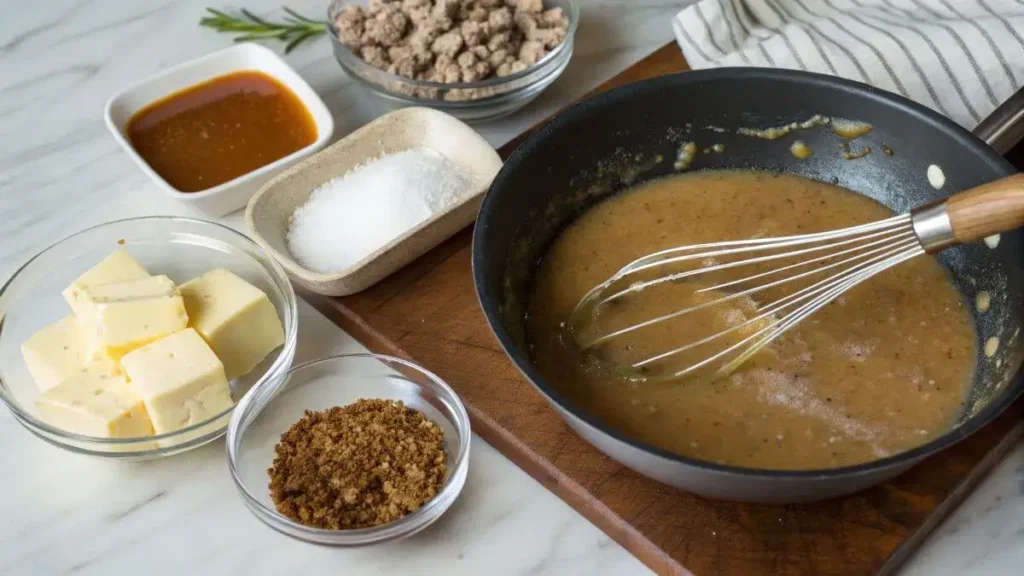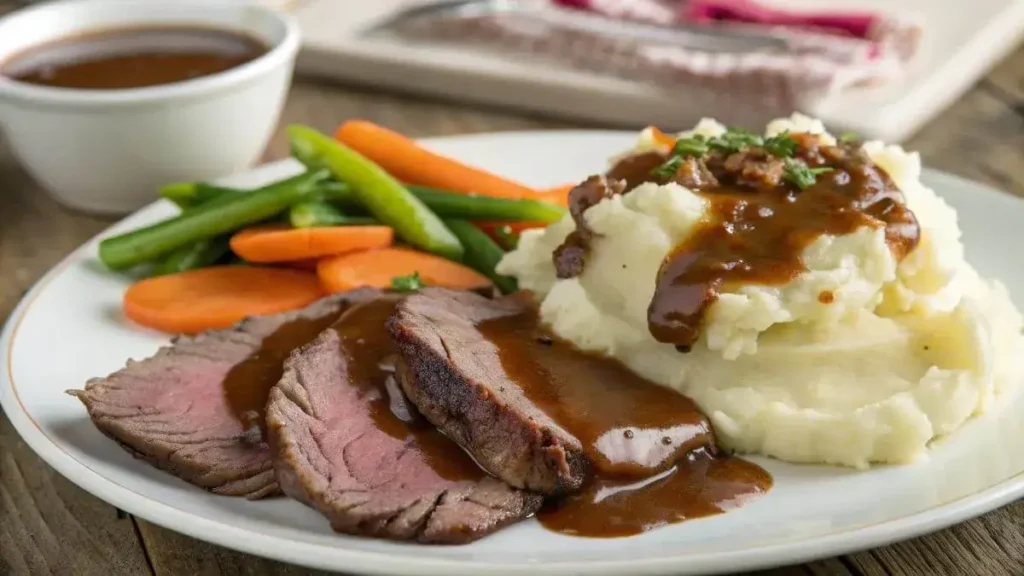Gravy Recipe is more than just a condiment; it’s a comforting sauce that adds warmth and richness to almost any dish. Whether drizzled over creamy mashed potatoes or smeared onto roasted turkey, gravy elevates meals with its savory flavors. In this guide, we’ll explore the ins and outs of gravy recipes, making it easy for anyone to whip up this classic sauce at home. From understanding the various types of gravy to crafting the perfect base, enhancing flavors, and troubleshooting common issues, we’ve got you covered. So roll up your sleeves, gather your ingredients, and dive into the delicious gravy world!
Understanding gravy
What is Gravy?
Gravy is, at its core, a sauce made from the drippings of cooked meat mixed with a thickener. Traditionally, it’s been a way for chefs to collect those flavorful juices left behind in the pan, turning them into a delectable sauce that enhances the dish. Over time, people have crafted many variations. This versatility means there’s a gravy recipe out there for every palate.
Types of Gravy
When it comes to gravy, there’s no shortage of options! Let’s break down some common types:
- Brown Gravy: Made from roasted meat juices, this gravy is often thickened with flour or cornstarch. It’s a must-have accompaniment to roast beef or turkey, giving those dishes a rich, savory finish.
- White Gravy (or Country Gravy): Think biscuits and gravy! This creamy indulgence is usually made with a roux of butter, flour, and milk. It’s the star of many Southern breakfasts and breakfast burritos.
- Vegetarian and Vegan Gravy: Not a meat-lover? No problem! This variety is made with vegetable stock or broth and often includes mushrooms, herbs, and spices for a savory flavor that holds up well against meat dishes.
- Seafood Gravy: Unique and often overlooked, this gravy brings in flavors from seafood stocks, perfect for dishes that call for a touch of the ocean, like crab cakes or shrimp.
- Creamy Gravies: These gravies are characterized by dairy, often resulting in a thick and luscious sauce. They’re perfect for pairing with pasta or those comfort food classics.
Basic Gravy Recipe
Essential Ingredients for a Basic Gravy
When mastering a gravy recipe, knowing the key ingredients is crucial. Here are the essential components you’ll need:

- Fat: Typically, this is rendered fat from the meat you’ve cooked (like drippings) or butter if you start from scratch. This fat gives your gravy its rich flavor.
- Flour: This thickening agent helps create that smooth, luscious texture we all love in gravy. All-purpose flour works perfectly, but you can also use cornstarch for a gluten-free alternative.
- Liquid: For a flavor-packed gravy, you’ll want to use stock or broth (beef, chicken, or vegetable), which adds depth to your sauce. You can also use water in a pinch, but it won’t pack the same punch.
- Seasoning: Salt and pepper are your go-to staples, but don’t be afraid to experiment! Adding herbs and spices like garlic powder, onion powder, or thyme can elevate your gravy recipe significantly.
Step-by-Step Instructions for Making Basic Gravy
Now that you have your ingredients, let’s create that smooth, delectable gravy!
- Start with Drippings: If you’re using meat drippings, save those tasty bits left in the pan after cooking your meat. If not, melt 1/4 cup of butter in a saucepan over medium heat.
- Whisk in the flour: Sprinkle 1/4 cup once your fat is hot. Whisk until well combined and cook for 1-2 minutes until golden brown. This creates a roux, which is the base for your gravy.
- Add Your Liquid Slowly: Gradually whisk 2 cups of your stock or broth to the roux. Doing this slowly will help avoid lumps. As you whisk, the mixture will begin to thicken.
- Season to Taste: After your Gravy is thickened to your liking, season it with salt, pepper, and any additional spices you prefer.
- Serve Hot: Pour your homemade gravy over your favorite dishes like mashed potatoes, turkey, or chicken. Enjoy!

This simple gravy recipe is easy to follow and forms the foundation for countless variations. Once you’ve nailed this basic gravy, you’ll find that you can incorporate different flavors and styles as you continue growing your culinary skills.
Variations of Gravy
Brown Gravy Recipe
Let’s take your gravy recipe to the next level! Brown gravy is a classic, perfect for a wide range of dishes. Here’s how to make it:
- Ingredients: You’ll need meat drippings, 1/4 cup of flour, 2 cups of beef broth, and seasoning.
- Instructions: Start by collecting drippings from roast beef. Heat the drippings over medium heat in a skillet and whisk in the flour. Cook until lightly browned. Gradually add the beef broth, stirring continuously, until thickened. Season to taste with salt and pepper.
White Gravy (Country Gravy) Recipe
If you love biscuits and gravy, this white gravy recipe is a must-know!
- Ingredients: Gather 1/4 cup butter, 1/4 cup flour, 2 cups milk, and salt and pepper to taste.
- Instructions: Melt the butter in a saucepan over medium heat. Whisk in the flour and cook until golden. Slowly add the milk, continuing to whisk until smooth and thick. Season with salt and pepper.
Vegetarian and Vegan Gravy Options
No meat? No problem! You can still enjoy tasty gravy.
- Ingredients: Use 1/4 cup olive oil, 1/4 cup flour, 2 cups vegetable stock, and nutritional yeast for that umami flavor.
- Instructions: Heat the olive oil in a saucepan and whisk in the flour until it forms a roux. Gradually pour in the vegetable stock, whisking continuously until smooth. Stir in nutritional yeast and season to taste.
Seafood Gravy Recipe
Seafood gravy adds a unique twist!
- Ingredients: Combine 1/4 cup butter, 1/4 cup flour, 2 cups fish stock, and shrimp or crab meat.
- Instructions: In a saucepan, mix butter and flour to create a roux. Slowly add fish stock until thickened. Stir in seafood, heat through, and serve over rice.
Creamy Gravies
These gravies are more decadent with the addition of cream.
- Ingredients: Use any basic gravy recipe, but add 1 cup of heavy cream once the sauce is thickened.
- Instructions: Follow the steps of the essential gravy recipes and incorporate the cream just before serving for that creamy finish.
With these variations, you can adapt the traditional gravy recipe according to your preference and dietary needs! Feel free to experiment and make it your own, ensuring your meals are always flavorful and comforting.
Flavor Enhancements for Gravy
Utilizing Broths and Stock
A rich broth or stock can make a difference when crafting the perfect gravy recipe. Instead of using plain water, opt for beef, chicken, or vegetable broth. The broth is packed with flavor and infuses your gravy with a depth water can’t provide.
Make your stock at home by simmering bones, vegetables, and herbs. This not only guarantees freshness but also lets you control the seasoning. If you’re using store-bought broth, double-check the label for low-sodium options to reduce excess salt. Adding this flavorful foundation can elevate your gravy from ordinary to extraordinary!
Herbs and Spices That Pair Well with Gravy
To enhance your gravy recipe, don’t shy away from using herbs and spices! A pinch of dried thyme, rosemary, or sage can bring delightful new flavors to your sauce. These herbs pair beautifully, especially in white or brown gravies.
Garlic and onion powder can also make a big difference. Imagine drizzling your homemade gravy over mashed potatoes and tasting the burst of herbs with each bite. A dash of cayenne or black pepper can spice things up if you like a bit of heat. Remember, start small; you can always add more, but you can’t remove it once it’s in!
Adding Savory Ingredients
You can further amp up the flavor of your gravy by adding savory ingredients like mushrooms or caramelized onions. Sautéing mushrooms until golden brown and incorporating them into your gravy can create a rich, earthy flavor that satisfies you.
For a touch of sweetness and depth, caramelized onions can do wonders. Sauté them slowly until they turn golden and sweet, then mix them into your gravy.
These additions enhance the taste of your gravy recipe and add texture and depth.
Gravy Pairings: What Goes with Gravy?
Classic Dishes Served with Gravy

Gravy is synonymous with comfort food, and it’s hard to imagine a successful dinner without it! When you think of classic dishes served with gravy, your mind likely drifts to mashed potatoes and roast turkey, right? These staples are practically designed for drenching in a delicious sauce.
Besides these favorites, consider serving gravy over rice or noodles. Chicken and rice topped with a generous helping of sauce is a family-favorite dish that’s simple yet satisfying. And don’t forget biscuits! A warm biscuit soaked in creamy gravy is pure heaven in every bite.
Creative Gravy Pairings
If you want to get creative, think outside the box! Ever tried adding gravy to pizza? That’s right! Drizzling savory gravy on cheesy pizza can create a unique flavor experience that’ll take your taste buds on a wild ride.
Consider using gravy on your breakfast sandwiches. A soft biscuit or English muffin layered with eggs, cheese, and a drizzle of gravy makes for a fantastic start to the day.
Gravy can even be used in gourmet burgers for those craving a little more flair. Imagine biting into a juicy burger topped with crispy onion rings and a generous helping of rich gravy. It’s a delicious surprise that your friends and family will love!
Troubleshooting Your Gravy
Gravy Too Thin? Solutions to Thicken Your Gravy
One common problem that cooks often face while making a gravy recipe is ending up with a sauce that’s too thin. Don’t worry; this is a very fixable issue! Here are some effective techniques to thicken your gravy:
- Flour or Cornstarch Slurry: If your Gravy looks too runny, mix equal parts flour or cornstarch with cold water to create a slurry. Gradually whisk this mixture into your gravy while it’s simmering. Keep stirring until you see the gravy thicken to your desired consistency.
- Reduce the Gravy: Another way to thicken gravy is by simply letting it simmer without a lid. This method concentrates the flavors while evaporating some of the liquid. Just be careful not to let it boil too vigorously, or you might end up with a burnt taste.
- Add Instant Mashed Potatoes: As a quick and easy fix, sprinkle a spoonful of instant mashed potatoes into your thin gravy. Stir it in and watch as your gravy thickens almost instantly. Plus, it adds a lovely flavor!
Gravy Too Thick? How to Fix It
Conversely, if your gravy has turned out too thick, there’s no need to start over. Here’s how to rescue it:
- Add Liquid: Stir in some additional stock or broth, a little at a time, to reach your preferred thickness. This works well because it maintains the gravy’s flavor.
- Incorporate Milk or Cream: You could use milk or cream to thin out your gravy for added richness. Gradually mix it in while stirring to achieve a smooth texture.
- Enhance with Butter: Adding a knob of cold butter can not only thin the gravy but also enrich its flavor. Just drop it in, stir, and let it melt.
Incorporating Flavors After Cooking
If you taste your gravy and find it lacking in flavor after cooking, don’t despair! You can still enhance it even at this stage.
- Season and Adjust: Double-check if it needs more salt or pepper. Sometimes, this simple adjustment can make all the difference.
- Add Fresh Herbs: Stir in fresh herbs like parsley, chives, or thyme at the end for a burst of freshness that invigorates your gravy.
- Boost with Acidity: A splash of vinegar or a squeeze of lemon juice can brighten up your gravy and add complexity. Be careful not to overdo it; start with a tablespoon, taste, and adjust.
Gravy FAQs
Answering Common Questions About Gravy Recipes
You might still have some questions floating around in your mind about making gravy. Don’t worry; we’ve got you covered! Here are some frequently asked questions regarding gravy recipes:
1. Can I make gravy ahead of time?
Absolutely! You can prepare gravy in advance and store it in the refrigerator for up to three days. Just reheat it gently on the stove before serving, adding a little stock if it thickens too much.
2. Is gravy gluten-free?
This depends on the ingredients. Traditional gravies often use flour, which contains gluten. However, you can easily make a gluten-free gravy recipe using cornstarch or gluten-free flour as a thickener.
3. How can I make my gravy less salty?
If your gravy is too salty, add more liquid to dilute it. Remember that this may also thin out your sauce, so be careful!
4. What can I use instead of meat drippings?
If you’re vegetarian or have no drippings, you can use vegetable stock or a combination of broth and soy sauce. This will still provide a savory flavor in your gravy recipe.
5. How do I store leftover gravy?
Cool your leftover gravy to room temperature before storing it in an airtight container. It can be kept in the fridge for about 3 days or freeze it for up to 3 months. Just remember to thaw and reheat gently!
Conclusion and Final Thoughts
In conclusion, mastering a gravy recipe can genuinely elevate your cooking game. Throughout this guide, we’ve explored the basics, variations, and enhancements to help you create the ideal sauce for your favorite meals. From understanding the essential ingredients to troubleshooting, pairing, and answering common questions, you now have the tools to navigate the gravy world.
Gravy isn’t just about adding a sauce; it’s about amplifying the flavors of your dishes, providing comfort, and creating a satisfying experience at the dining table. Don’t hesitate to experiment with different types, ingredients, and techniques—it’s all part of the fun!
Next time you’re in the kitchen, remember the tips and tricks in this article and let your creativity flow while crafting that perfect gravy. Whether for a holiday feast, a weeknight dinner, or a comforting brunch, you can be confident knowing you’ve got the know-how to make gravies that’ll impress your family and friends.
Print
Gravy Recipes The Ultimate Guide to: Learn, Create, and Savor!
Description
Gravy is more than just a condiment; it’s a comforting sauce that adds warmth and richness to almost any dish. Whether drizzled over creamy mashed potatoes or smeared onto roasted turkey, gravy elevates meals with its savory flavors. In this guide, we’ll explore the ins and outs of gravy recipes, making it easy for anyone to whip up this classic sauce at home. From understanding the various types of gravy to crafting the perfect base, enhancing flavors, and troubleshooting common issues, we’ve got you covered. So roll up your sleeves, gather your ingredients, and dive into the delicious gravy world!
Ingredients
Essential Ingredients for a Basic Gravy
When mastering a gravy recipe, knowing the key ingredients is crucial. Here are the essential components you’ll need:
- Fat: Typically, this is rendered fat from the meat you’ve cooked (like drippings) or butter if you start from scratch. This fat gives your gravy its rich flavor.
- Flour: This thickening agent helps create that smooth, luscious texture we all love in gravy. All-purpose flour works perfectly, but you can also use cornstarch for a gluten-free alternative.
- Liquid: For a flavor-packed gravy, you’ll want to use stock or broth (beef, chicken, or vegetable), which adds depth to your sauce. You can also use water in a pinch, but it won’t pack the same punch.
- Seasoning: Salt and pepper are your go-to staples, but don’t be afraid to experiment! Adding herbs and spices like garlic powder, onion powder, or thyme can elevate your gravy recipe significantly.
Instructions
Step-by-Step Instructions for Making Basic Gravy
Now that you have your ingredients, let’s create that smooth, delectable gravy!
- Start with Drippings: If you’re using meat drippings, save those tasty bits left in the pan after cooking your meat. If not, melt 1/4 cup of butter in a saucepan over medium heat.
- Whisk in the flour: Sprinkle 1/4 cup once your fat is hot. Whisk until well combined and cook for 1-2 minutes until golden brown. This creates a roux, which is the base for your gravy.
- Add Your Liquid Slowly: Gradually whisk 2 cups of your stock or broth to the roux. Doing this slowly will help avoid lumps. As you whisk, the mixture will begin to thicken.
- Season to Taste: After your Gravy is thickened to your liking, season it with salt, pepper, and any additional spices you prefer.
- Serve Hot: Pour your homemade gravy over your favorite dishes like mashed potatoes, turkey, or chicken. Enjoy!
schema
Understanding Gravy
- What is Gravy?
Explore the origins and basics of gravy, discussing its various forms and uses in cuisine. - Types of Gravy
Breakdown the most common types of gravy, such as brown gravy, white gravy, and vegan gravy alternatives.
Basic Gravy Recipe
- Essential Ingredients for a Basic Gravy
Detail the key ingredients needed for making a simple gravy and their functions. - Step-by-Step Instructions for Making Basic Gravy
Provide a clear, easy-to-follow recipe for making traditional gravy from scratch. - Common Mistakes to Avoid
Discuss frequent mistakes people make while making gravy and tips to prevent them.
Variations of Gravy
- Brown Gravy Recipe
An in-depth recipe for classic brown gravy, including tips for customization. - White Gravy (Country Gravy) Recipe
Step-by-step guide on preparing white gravy typically served with biscuits. - Vegetarian and Vegan Gravy Options
Discover how to create delicious meat-free gravies that are just as flavorful.
Flavor Enhancements for Gravy
- Utilizing Broths and Stock
Explain how different types of broth can be used to enhance gravy flavor. - Herbs and Spices That Pair Well with Gravy
Discuss various herbs and spices that can elevate the taste of your gravy, including thyme, rosemary, and garlic. - Adding Savory Ingredients
How to incorporate mushrooms, caramelized onions, or even wine into gravies.
Gravy Pairings: What Goes With Gravy?
- Classic Dishes Served with Gravy
Explore traditional dishes such as mashed potatoes, turkey, biscuits, and roast meats. - Creative Gravy Pairings
Suggest modern and unexpected pairings like pizza or pasta.
Troubleshooting Your Gravy
- Gravy Too Thin? Solutions to Thicken Your Gravy
Provide methods on how to thicken gravy, including flour, cornstarch, and reduction techniques. - Gravy Too Thick? How to Fix It
Tips on how to adjust overly thick gravy to reach the desired consistency. - Incorporating Flavors After Cooking
What to do if the gravy lacks flavor after cooking and how to adjust it.
Gravy FAQs
- Answering Common Questions About Gravy Recipes
Compile frequently asked questions related to making gravy (based on the ‘People Also Ask’ section on Google).
Conclusion and Final Thoughts.

